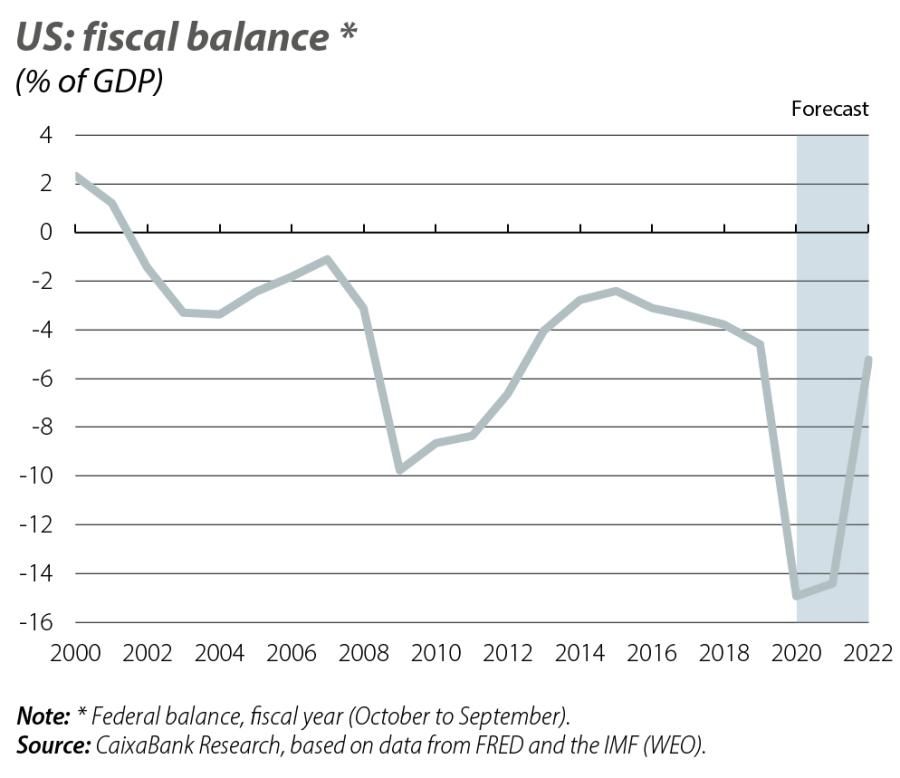Fiscal activism in the US: a lot of noise and little substance?
Fiscal activism is not declining in the US. Following the vast disbursements of 2020 and 2021, fiscal activity is now focusing on negotiations regarding the new stimulus packages proposed by the Biden administration: The American Jobs Plan (AJP, which revolves around infrastructure) and The American Family Plan (AFP, with a social focus). But what can we expect to come out of these negotiations?

First, in early autumn Congress ought to have already approved part of the measures proposed in the AJP, focusing on improving the country’s classic infrastructure (roads, water, etc.). Although the amount set out is small, at around 550 billion dollars in new expenditure to be distributed over 10 years, this is the first agreement on the proposals that Biden presented last spring.1
On the other hand, during the summer it was agreed that many of the proposals under the AJP and AFP would be discussed under a reconciliation process, thus establishing a budget of 3.5 trillion dollars to be distributed over 10 years. This legal path allows Congress to approve expenditure and taxes with a simple majority, and it usually facilitates the passage of the bill that is presented in the House of Representatives and the Senate (even more so when both chambers are in Democratic hands). Nevertheless, reconciliation entails a prior process of drafting proposals for the bill that can end up being complex. After all, views on fiscal matters vary widely, even within the Democratic party itself.2
- 1. The federal infrastructure expenditure to be agreed amounts to 1 trillion dollars, but the new expenditure equates to 550 billion. Also, according to the Congressional Budget Office (CBO) and other agencies, the net stimulus could be even lower (between 250 and 400 billion) once other measures accompanying the agreement are considered, such as the reduction in spending in other areas. The first vote which was due to take place at the end of September was postponed.
- 2. The reconciliation process usually begins with a preliminary agreement between Democrats and Republicans on a budget resolution. Various committees are then established (with members of both parties) which must propose specific expenditure and tax elements. Based on these proposals, a bill is prepared and presented in the two chambers of Congress for approval and, finally, they must be ratified by the president. Today, the Democratic majority in the Senate is very fragile, since the tie-breaker is in the hands of the vice-president.
There has been a frenzy of fiscal activity over the last year and a half in order to support citizens and businesses during the pandemic. Between March 2020 and March 2021, the US leadership approved measures amounting to around 6 trillion dollars (some 25% of the country’s GDP).3 Although some of these measures will be extended until 2022, most of the disbursements will have occurred between 2020 and 2021, with a very considerable increase in the country’s public deficit (see first and second charts).
- 3. Most of the measures were in the form of direct spending.


In this regard, the end of these massive programmes in the coming quarters will mean a substantial decline in fiscal support for the US economy (an effect we will see as early as the closing stages of 2021). The knock-on capacity of the new proposals (AJP and AFP) is limited, especially in the short term. Firstly, on an annual basis the infrastructure and social spending could amount to some 300 billion dollars,4 which pales in comparison to the more than 2 trillion dollars spent annually in the past two years. Furthermore, these programmes would be accompanied by tax hikes aimed at higher incomes, as well as large corporations, which detracts from their ability to stimulate the economy compared to if they were financed through deficits.5 For illustrative purposes, following the disbursements which have added more than 6 pps to GDP growth rates, in the coming quarters fiscal measures could end up dragging down economic growth by around 4 pps.6
Nevertheless, this way of financing higher spending should not be viewed as negative. Today, the strong recovery we are witnessing in economic activity makes it unnecessary and even counter-productive to continue with large-scale fiscal stimulus measures. The withdrawal of the fiscal stimulus leaves way for the revival of private demand. In this regard, US growth will still be at solid levels in the coming quarters (see third chart).
- 4. This is in a relatively optimistic scenario in terms of bipartisan consensus. Moreover, according to various analyses, the expected disbursements will likely be somewhat less in the first few years and will reach their peak between 2024 and 2026.
- 5. See the working paper by the Congressional Budget Office: J. Nelson and K. Phillips (2021). «The Economic Effects of Financing a Large and Permanent Increase in Government Spending». Working Paper 2021-03, nº 57021.
- 6. For the direct spending measures, we use the most recent tax multipliers published by the CBO for the CARES Act. For the infrastructure measures, we take multipliers in the low-medium range of estimates, since in the short term the impact is lower and many of the spending measures will also be accompanied by tax increases.

- 1. The federal infrastructure expenditure to be agreed amounts to 1 trillion dollars, but the new expenditure equates to 550 billion. Also, according to the Congressional Budget Office (CBO) and other agencies, the net stimulus could be even lower (between 250 and 400 billion) once other measures accompanying the agreement are considered, such as the reduction in spending in other areas. The first vote which was due to take place at the end of September was postponed.
- 2. The reconciliation process usually begins with a preliminary agreement between Democrats and Republicans on a budget resolution. Various committees are then established (with members of both parties) which must propose specific expenditure and tax elements. Based on these proposals, a bill is prepared and presented in the two chambers of Congress for approval and, finally, they must be ratified by the president. Today, the Democratic majority in the Senate is very fragile, since the tie-breaker is in the hands of the vice-president.
- 3. Most of the measures were in the form of direct spending.
- 4. This is in a relatively optimistic scenario in terms of bipartisan consensus. Moreover, according to various analyses, the expected disbursements will likely be somewhat less in the first few years and will reach their peak between 2024 and 2026.
- 5. See the working paper by the Congressional Budget Office: J. Nelson and K. Phillips (2021). «The Economic Effects of Financing a Large and Permanent Increase in Government Spending». Working Paper 2021-03, nº 57021.
- 6. For the direct spending measures, we use the most recent tax multipliers published by the CBO for the CARES Act. For the infrastructure measures, we take multipliers in the low-medium range of estimates, since in the short term the impact is lower and many of the spending measures will also be accompanied by tax increases.



